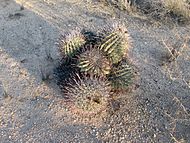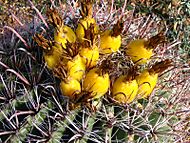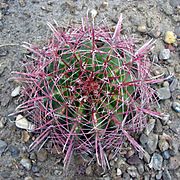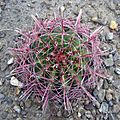Fishhook barrel cactus facts for kids
Quick facts for kids Ferocactus wislizeni |
|
|---|---|
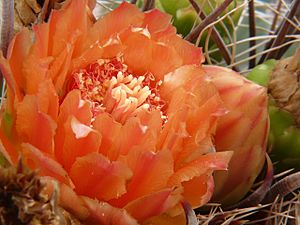 |
|
| Scientific classification | |
| Kingdom: | |
| (unranked): | |
| (unranked): | |
| (unranked): | |
| Order: | |
| Family: | |
| Genus: |
Ferocactus
|
| Species: |
F. wislizeni
|
| Binomial name | |
| Ferocactus wislizeni (Engelm.) Britt. & Rose
|
|
| Synonyms | |
|
Echinocactus wislizeni Engelm. |
|
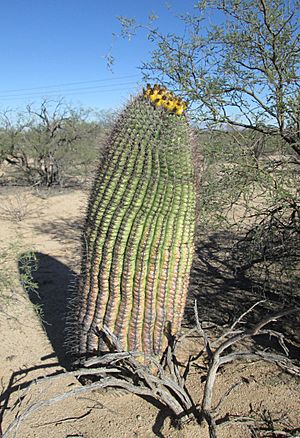
The Ferocactus wislizeni, often called the fishhook barrel cactus, is a cool plant in the cactus family. You might also hear it called the Arizona barrel cactus or candy barrel cactus. It grows naturally in northern Mexico and the southern United States.
This cactus starts out shaped like a ball. As it gets older, it grows taller and becomes more like a cylinder. It has spiny ribs and beautiful red or yellow flowers that bloom in the summer.
Contents
What It Looks Like
The fishhook barrel cactus usually grows to be about 2.25 feet (0.7 meters) wide. It can reach a height of 3 to 6 feet (0.9 to 1.8 meters). Some really big ones have been found that are 3 feet (0.9 meters) wide and 10 feet (3 meters) tall!
Its common name, "fishhook barrel cactus," comes from its thick, hooked spines. These spines look a lot like fishhooks. The cactus has a tough, leathery skin that is a green color, like asparagus. It also has about 15 to 28 ribs running down its sides.
Flowers and Fruit
The flowers of this cactus are yellow to red-orange. They grow on top of the cactus during the summer. After the flowers dry up, they leave behind fruit. The fruit starts green and turns yellow. It can stay on the cactus for a long time, sometimes even more than a year!
Why It Leans South
When fishhook barrel cacti get older, they often lean towards the south. This is why some people call them "compass barrel cacti." One idea is that the strong afternoon sun slows down growth on the side facing the sun. This makes the plant grow unevenly and lean.
Very old cacti can lean so much that they fall over. This often happens after heavy rains when the soil becomes loose. These cacti can live for a long time, usually 50 to 100 years.
Where It Grows
Fishhook barrel cacti like to grow in places where water collects for short times. You can often find them on rocky ridges and open areas called bajadas. They don't usually grow in washes or dry creek beds.
Spines for Protection
The "fishhook" spines and the thick web of spines around the cactus protect it. They help keep animals from eating the cactus. It's rare to find a barrel cactus that has been hollowed out by javelinas. Other cacti, like prickly pear, get much more damage from animals.
The spines are very sharp and can easily go through boots and gloves. The roots of the cactus are quite long, but they don't go very deep into the ground.
Where It Lives
The fishhook barrel cactus is found in the southwestern United States and northwestern Mexico. You can see it in southern Arizona, southern New Mexico, and El Paso County, Texas. It also grows in northern parts of Sonora and Chihuahua, Mexico.
This cactus prefers sandy or gravelly soil. It grows best in full sun and hot, dry weather. It can be found at elevations from 1,000 to 5,300 feet (300 to 1,600 meters). It can even handle cold temperatures down to 5°F (-15°C).
Life in the Desert
The flowers of the fishhook barrel cactus are pollinated by special cactus bees. Many animals enjoy eating the fruit. Mule deer, birds, and javelinas all munch on it. Birds especially like the seeds inside the fruit.
Uses by People
People living in the Sonoran Desert have used the fruit of this cactus for a long time. They make it into candy and jelly. The Seri and O'odham tribes would eat the flowers. They also used the sour fruit as emergency food.
You might hear stories that the barrel cactus can give water to people lost in the desert. Native Americans did use it for this purpose in the past. However, the water inside is not very good to drink and can make you sick if you drink it on an empty stomach.
Fire Resistance
As the cactus gets older, its skin becomes thicker. This helps older cacti survive fires better. Even so, about half to two-thirds of these cacti can die within two years after a fire.
Cactus in Your Garden
In towns and cities, the fishhook barrel cactus is a popular plant for gardens. It doesn't need much water, which makes it great for xeriscaping (gardening with little water). It's also easy to take care of and loves sunny spots.
Gallery
-
Fishhook barrel cactus cluster near Sahuarita, Arizona.
Images for kids
See also
 In Spanish: Biznaga de agua para niños
In Spanish: Biznaga de agua para niños



